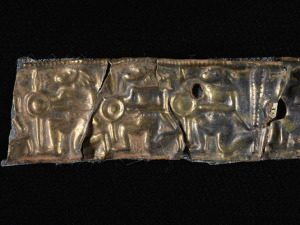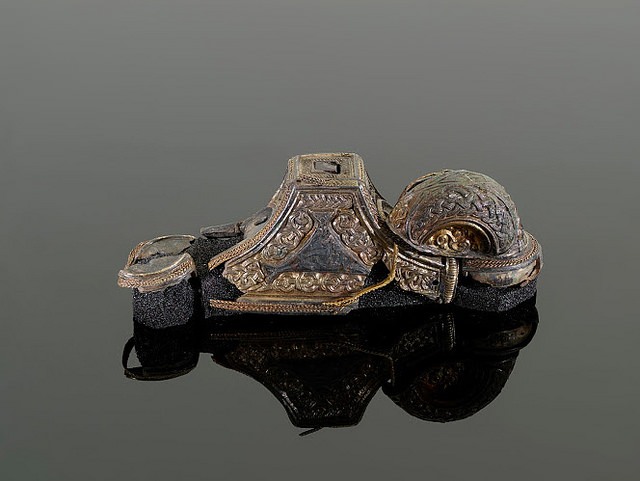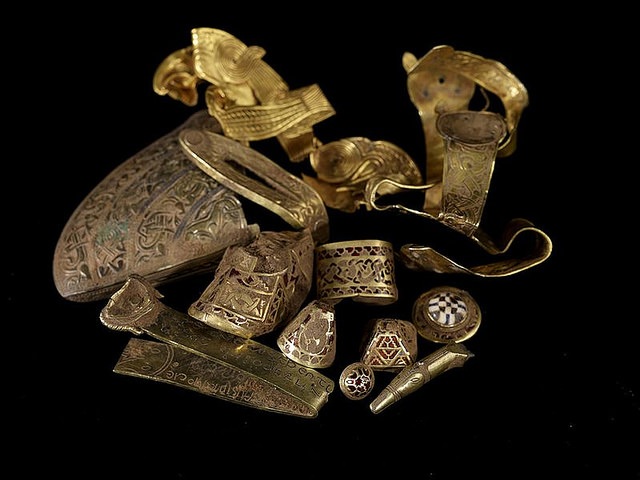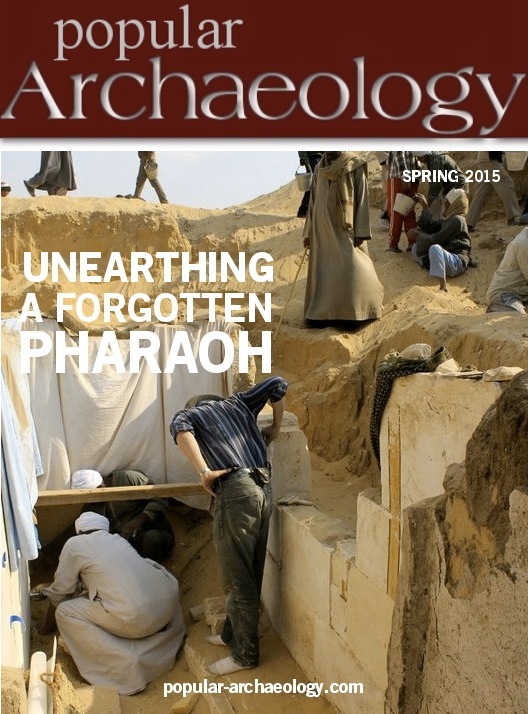 Detail of the reconstructed helmetband, depicting a frieze of warriors(c) Birmingham Museums Trust
Detail of the reconstructed helmetband, depicting a frieze of warriors(c) Birmingham Museums Trust Researchers and conservators have revealed two rare objects that promise to shed new light on knowledge of seventh century Anglo-Saxon England, a period of time known as the ‘dark age’ in the British Isles. One is a seventh century helmet, the other an unusual sword pommel.
After years of cleaning, treatment and building on previous research conducted by specialized teams in the UK, researchers and conservators of Barbican Research Associates are painstakingly piecing together the thousands of fragments of objects that constitute what is arguably considered one of the world’s greatest archaeological treasures—the Staffordshire Hoard, first discovered in a field in Staffordshire, England in 2009 by a metal detectorist. While the helmet and sword pommel are only two among hundreds of other important gold and silver metalwork objects identified among the Staffordshire Hoard fragments, their rarity and uniqueness distinguish them among an otherwise remarkable collection of objects presumably belonging to an elite class warrior or important person likely associated with one of the Anglo-Saxon kingdoms of the seventh century. Generally, the objects of the Hoard consist mostly of fittings from weaponry, reflecting a turbulent time in English history when competing small kingdoms fought for dominance. Comparatively little is known about this ‘dark’ period of history, which emerged after germanic peoples migrated to the southern and eastern areas of the main island from mainland Europe (becoming the various Anglo-Saxon kingdoms) in the centuries after the Romans abandoned occupation of the British Isles during the long decline of their Imperial Period rule over much of the ancient world.
The Helmet
Archaeologists and a conservator worked for three solid days to begin to piece together the helmet’s vast array of some 1,500 thin, fragile silver sheets and strips. Anglo-Saxon helmets are incredibly rare, and the hoard example is only the fifth to be discovered. The painstaking job saw these fragments—many less than 10 mm across and making up around a third of the Hoard in size—pieced together to reveal intricate, die-stamped designs. The designs depict human warriors and male moustachioed faces, as well as birds, animals and mythical beasts, like others seen in the rest of the hoard. Some warrior figures themselves wear helmets. Researchers suggest that it is possible these are ancestral or idealized warriors, intended to give spiritual support to the wearer.
The team also pieced together the fragments of a ‘helmet-band’, thought to have run around the circumference of the helmet (and which featured one of the warrior friezes). Many of the sheet friezes were gilded with gold. In comparison, the helmet found at Sutton Hoo in 1939, in the royal ship-burial, was silver.
“The helmet, if covered in all the gilt foils in the collection, would have looked spectacular,” said Pieta Greaves, the Staffordshire Hoard Conservation Coordinator with the Birmingham Museums Trust, “not only because it would have appeared gold but because it is unique, only being the 5th helmet [of its kind] found in Britain. It was probably worn by a King or someone of great importance.”
Scientists say there is still much more to be discovered about this helmet, and work continues.
____________________________________________
 Section of the reconstructed helmetband, depicting a frieze of warriors. Courtesy Birmingham Museums Trust
Section of the reconstructed helmetband, depicting a frieze of warriors. Courtesy Birmingham Museums Trust
_____________________________________________
 Detail of the reconstructed helmetband, depicting a frieze of warriors. Courtesy Birmingham Museums Trust
Detail of the reconstructed helmetband, depicting a frieze of warriors. Courtesy Birmingham Museums Trust
_____________________________________________
 The helmet of Sutton Hoo reconstructed as it would have appeared in its day. The Staffordshire helmet would have looked much like this, but it would have likely contained more gold features, and would have displayed a gold appearance, as opposed to the the silver appearance of the Sutton Hoo helmet. Gernot Keller, Wikimedia Commons
The helmet of Sutton Hoo reconstructed as it would have appeared in its day. The Staffordshire helmet would have looked much like this, but it would have likely contained more gold features, and would have displayed a gold appearance, as opposed to the the silver appearance of the Sutton Hoo helmet. Gernot Keller, Wikimedia Commons
_______________________________________________________________
The Pommel
There are over seventy pommels (the part of the sword that fits at the end of a sword-grip) in the Hoard, but the newly constructed one is unique among the finds. Conservation and research teams identified and reassembled it from 26 fragments. Although Anglo-Saxon in style, it also features British or Irish art influences. Its central garnet and glass inlaid disc can be seen to form an early Christian cross, while on its opposite side is a motif formed of three serpents. Thus, both Christian and pagan beliefs may be represented. It is also decorated with gold filigree (fine wire ornament), and inlaid with niello (a black inlay formed from copper, silver, and lead sulfides). Most unusual is the rounded hump on the pommel’s shoulder, known as a ‘sword-ring’—there would have been two originally, one on each shoulder. Many swords from this period in England and Europe have such rings, but the hoard pommel is the first to feature two. This, with its lavish ornament, suggests that it possibly belonged to an individual of significant status. Said Chris Fern, project archaeologist, “The newly recognized pommel is truly exciting. It combines multiple different styles of ornament, much in the same way as the earliest 7th century illuminated manuscripts do, like the Book of Durrow. It suggests the coming together of Anglo-Saxon and British or Irish high cultures.”
_______________________________________________
 The front of the reconstructed sword pommel. Courtesy Birmingham Museums Trust
The front of the reconstructed sword pommel. Courtesy Birmingham Museums Trust
_______________________________________________________________
 The back of the reconstructed sword pommel. Courtesy Birmingham Museums Trust
The back of the reconstructed sword pommel. Courtesy Birmingham Museums Trust
_______________________________________________________________
The Hoard’s Legacy
Archaeologists consider the Staffordshire Hoard the most spectacular Anglo-Saxon find since the excavation of the Sutton Hoo ship-burial (Suffolk) in 1939. It consists of a mix of gold, silver and garnet items weighing over 6 kg. Most of the items were stripped from swords and seaxes (single-edged fighting knives), at least one helmet and other items, and probably represent the equipment of defeated armies from unknown battles of the first half of the 7th century. And although fragmented, damaged and distorted, the hoard’s objects represent the possessions of an elite warrior class, as reflected in their craftsmanship and ornamentation.
Said Greaves, “We have all these great Anglo-Saxon poems which talk about the warrior elite, but this is the first evidence we have that they really existed.”
Why it was buried, perhaps before c 675 AD, remains an unanswered question. Significantly, it was discovered close to a then major route-way (Roman Watling Street), in what was the emerging Kingdom of Mercia. Warfare between England’s many competing regional kingdoms was frequent.
Said Fern, “The Staffordshire Hoard links us with an age of warrior splendour. The gold and silver war-gear was probably made in workshops controlled by some of England’s earliest kings, to reward warriors that served those rulers when multiple kingdoms fought for supremacy. The skill of the craftsmen is equally thrilling to behold, with many of the finds decorated with pagan and Christian art, designed to give spiritual protection in battle.”
______________________________________________
 Above: An assemblage of some of the major objects of the Hoard. Note the helmet cheek piece on the left. Courtesy David Rowan, Birmingham Museum and Art Gallery, Wikimedia Commons
Above: An assemblage of some of the major objects of the Hoard. Note the helmet cheek piece on the left. Courtesy David Rowan, Birmingham Museum and Art Gallery, Wikimedia Commons
______________________________________________________________
Detailed conservation and research of its approximate 4,000 fragments is not yet complete, and the second phase of research and conservation, now in its beginning stages, entails piecing together the fragments like a giant jigsaw puzzle, revealing the artifacts in their original form. Toward this end, the owners (Birmingham City Council and Stoke-on-Trent City Council) need to raise an additional £120,000 for this work to continue and to continue the research necessary to illuminate understanding of this unique window on Anglo-Saxon history. Much of the previous funding up to that point was provided by Historic England, a non-profit organization dedicated to promoting and supporting England’s historic environment.
Duncan Wilson, Historic England Chief Executive, said: “Since its discovery in 2009, the Staffordshire Hoard and the stories behind it have captured the public imagination. The research which Historic England has funded has started to uncover the secrets of this Anglo-Saxon treasure. As technology and research methods develop we are able to discover more and more, and share the results, but more money needs to be raised to capitalize fully on this rich potential.”
For more about the Staffordshire Hoard, see the official website and the article, Conserving the Staffordshire Hoard by Pieta Greaves, published in the March 1, 2014 issue of Popular Archaeology.
Individuals and groups interested in donating funds to help with this effort may do so by going to the website for more information.
__________________________________________________________
Parts of this article were adapted and edited from the subject press release and email interview with Pieta Greaves, Staffordshire Hoard Conservation Coordinator.
__________________________________________________________
The major organizational players in the Staffordshire Hoard project include:
The Birmingham Museums Trust, an independent charity that manages the city’s museum collection and venues on behalf of Birmingham City Council. It uses the collection of around 800,000 objects to provide a wide range of arts, cultural and historical experiences, events and activities that deliver accessible learning, creativity and enjoyment for citizens and visitors to the city. Most areas of the collection are designated as being of national importance, including the finest collection of Pre-Raphaelite art in the world. Attracting over 1 million visits a year, the Trust’s venues include Aston Hall, Birmingham Museum and Art Gallery, Blakesley Hall, Museum Collections Centre, Museum of the Jewellery Quarter, Sarehole Mill, Soho House, Thinktank and Weoley Castle. www.birminghammuseums.org.uk<http://www.birminghammuseums.org.uk>
Barbican Research Associates, the UK’s leading independent consultancy specialising in the analysis of archaeological finds and post-excavation management. Further information about the Staffordshire Hoard research project can be found on their website: http://www.barbicanra.co.uk/staffordshire-hoard.html
Birmingham Museums Trust
Stoke-on-Trent City Council, delivering hundreds of services to 249,000 residents, including two museums, leisure and culture facilities. The Potteries Museum and Art Gallery is one of these services, and boasts a series of internationally-renown exhibitions, including the world’s best collection of Staffordshire ceramics, and a Spitfire Mk LF XVI, designed by one of the city’s most famous sons, Reginald Mitchell. All of the museum’s collections of 700,000 objects are categorised as designated collections of national importance. Galleries also include fine and decorative arts, costume, local history, archaeology and natural history.
Historic England (formerly known as English Heritage), the public body that champions and protects England’s historic places. They look after the historic environment, providing expert advice, helping people protect and care for it and helping the public to understand and enjoy it.
___________________________________________________________
 Read more in-depth articles about archaeology with a premium subscription to Popular Archaeology Magazine.
Read more in-depth articles about archaeology with a premium subscription to Popular Archaeology Magazine.
In addition, the latest Popular Archaeology ebook is now available.
______________________________________________
Travel and learn with Far Horizons.
____________________________________________
 Popular Archaeology’s annual Discovery Edition eBook is a selection of the best stories published in Popular Archaeology Magazine in past issues, with an emphasis on some of the most significant, groundbreaking, or fascinating discoveries in the fields of archaeology and paleoanthropology and related fields. At least some of the articles have been updated or revised specifically for the Discovery edition. We can confidently say that there is no other single issue of an archaeology-related magazine, paper print or online, that contains as much major feature article content as this one. The latest issue, volume 2, has just been released. Go to the Discovery edition page for more information.
Popular Archaeology’s annual Discovery Edition eBook is a selection of the best stories published in Popular Archaeology Magazine in past issues, with an emphasis on some of the most significant, groundbreaking, or fascinating discoveries in the fields of archaeology and paleoanthropology and related fields. At least some of the articles have been updated or revised specifically for the Discovery edition. We can confidently say that there is no other single issue of an archaeology-related magazine, paper print or online, that contains as much major feature article content as this one. The latest issue, volume 2, has just been released. Go to the Discovery edition page for more information.
____________________________________________





